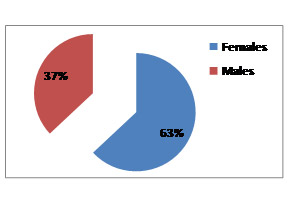Current Issues
Original Article
Epidemiological study on admitted cases of clinical Diphtheria at Sir Ronald Ross Institute of Tropical and Communicable Diseases, Hyderabad, Telangana.
*Corresponding Author
Dr.M.Vijay Kumar
Assistant professor, Department of Community medicine,
Bhaskar Medical College, Yenkapally, Moinabad, Ranga reddy district Telangana state, India – 500068.
Email Id: vijaykmbbs@gmail.com
1Assistant Professor, Department of Community Medicine, Bhaskar Medical College, Yenkapally (v), Moinabad (M), Rangareddy (Dist.), Telangana, India, 2Professor, Department of Community Medicine, Osmania Medical College, Koti, Hyderabad, Telangana State, India.
Abstract
Background: Diphtheria is a nasopharyngeal and skin infection caused by the exotoxin of Corynebacterium diphtheriae which has shown resurgence in the past decade.
Aims and Objectives: 1. To determine various epidemiological factors related to Diphtheria. 2. To determine morbidity and mortality of admitted cases of Diphtheria over the past one year.
Methodology: A retrospective hospital record based study was carried out at our institute, involving all clinical cases of diphtheria. Duration of the Study was for a period of 3 months. A pretested structured questionnaire which included demographic characteristics like age, sex, seasonal variation, religion, morbidity and mortality was used. Statistical analysis was done by using Microsoft Excel 2007 and EPI INFO 3.5.3 version.
Results: Out of 1338 cases, most of the study subjects were females (63%), Muslims (60%) and those who belong to urban areas (83%). Most of the study subjects belong to age group more than 20 years (48%). Average duration of stay of the patients in the hospital was 3-7 days. A total of 24 deaths have occurred among 1338 cases, giving a case fatality rate of 1.8%.
Conclusion: There is a shift in age group affected, with 48% occurring in >20years age group indicating the need of boosters every 10 years.
Key words: Clinical Diphtheria, Retrospective, epidemiological factors
Introduction
Most of the vaccine preventable diseases showed a decline after introduction of Expanded Programme of Immunization in 1978 and Universal Immunization Programme in 1985. Diphtheria is a nasopharyngeal and skin infection caused by the exotoxin of Corynebacterium diphtheria.1
The last decade has seen resurgence of Diphtheria in countries where it was previously well controlled.
Global Scenario of Reported cases of Diphtheria in 20142 revealed that out of 7324 cases reported world wide, 6094 were from India. India contributed to 83.2% of the total reported cases.2 A total of 55,533 cases were reported in India from the year 2000 to 2010.2 In Andhra Pradesh, total numbers of Diphtheria cases were 509 contributing to 15.22% in 2010.3
Sir Ronald Ross Institute of Tropical and Communicable Diseases is a Sentinel Surveillance site for all vaccine preventable diseases in and around Hyderabad. So, almost all cases of vaccine preventable diseases like diphtheria are generally referred to this hospital. It was therefore decided to analyze the recorded information and to bring out various aspects of diphtheria cases treated in the hospital.
Objectives
- To determine the epidemiological factors of admitted cases of Diphtheria
- To assess the morbidity and mortality of the admitted cases.
Material and Methods
The present study on diphtheria was based on the retrospective analysis of hospital case records. It was intended to bring out the epidemiological profile of clinical diphtheria cases admitted in the hospital from September 2010 to August 2011. Criteria for case description for probable and confirmed case was made as per World Health Organization (WHO) guidelines. All clinical cases which met the clinical criteria for diphtheria were included in the study. Duration of the study was for 3 months. A predesigned pre-tested proforma was used to get the information from the case records. Study variables included demographic characteristics like age, sex, seasonal variation, religion, morbidity and mortality. Statistical analysis was done by using Microsoft Excel 2007 and EPI INFO 3.5.3 version. Data was presented in percentages and proportions.
Case definition as per WHO guidelines4
Clinical Description
An illness characterized by laryngitis or pharyngitis or tonsillitis, and an adherent membrane of the tonsils, pharynx and/or nose.
Laboratory criteria for diagnosis
Isolation of Corynebacterium diphtheriae from a clinical specimen, or a fourfold or greater rise in serum antibody(but only if both serum samples are obtained before the administration of diphtheria toxoid or antitoxin).
Case classification 4
Probable: A case that meets the clinical description.
Confirmed: A case that is laboratory-confirmed or linked epidemiologically to a laboratory-confirmed case.
Immunization status
a) Fully immunized or completely immunized - who had primary series of three diphtheria toxoid injections, first booster and second booster injections or appropriate to their age. b) Partially immunized - who had no boosters or less than three primary injections or both. c) Unimmunized - who had never received a diphtheria toxoid injection.
Results
Analysis of the case records reviewed the following features of diphtheria.
Age and sex: Total number of Clinical Diphtheria cases admitted was 1338 from September 2010 to August 2011. Nearly half (48%) of the cases were 20 years and above (Fig.1). There were about 37% males and 63% females with male to female sex ratio at 1:1.7 (Fig.2). Religion wise distribution: Almost 60% (n=803) of the cases were from Muslim religion and 40% (n=535) were from Hindus by religion.

Fig.1: Age wise distribution

Fig.2: Sex wise distribution
Seasonal variation: Observations from the data revealed that maximum number of cases recorded were in the month of November to April (Table 1).
Area wise distribution: Majority of the cases 1110 (83%) belonged to urban areas especially from urban slums followed by 228 (17%) from rural areas.
Immunization status: Immunization status was not available in all the case sheets. Out of the 269 cases of clinical diphtheria whose information on immunization status was available, 104 (38.7%) were fully immunized, 152 (56.3%) were partially immunized and 13 (5%) were unimmunized.
Morbidity and mortality:
Number of cases in relation to staining and Culture: Smear for Klebs-Loeffler’s Bacilli has shown positive result in 18.7% (n=25) cases and negative in 81.3% (n=1313) cases. 12.3% of cases shown positive results in throat culture. Duration of stay in Hospital: More than half of the patients (55%) admitted spent an average of 3-7 days in the hospital. Mortality: A total of 24 deaths of Diphtheria were reported in the hospital in the one year duration of the study with case fatality rate was found to be 1.8%.
Table 1: Month wise distribution of cases
| Month | Clinical Diphtheria cases | |
| Number | Percentage | |
| 2010 | ||
| September | 79 | 5.9 |
| October | 91 | 6.8 |
| November | 129 | 9.6 |
| December | 125 | 9.3 |
| 2011 | ||
| January | 119 | 8.9 |
| February | 127 | 9.5 |
| March | 136 | 10.2 |
| April | 219 | 16.4 |
| May | 87 | 6.5 |
| June | 98 | 7.3 |
| July | 53 | 4 |
| August | 75 | 5.6 |
| Total | 1338 | 100 |
Discussion
In the present study, as the age increased distribution of the cases increased and majority of the cases were in the age group of >20 years (48%). There were about 37% males and 63% females. Male to Female Sex Ratio was 1:1.7. The median age of diphtheria was 17 years in a study done in Hyderabad and attack rates were lowest among infants, increased with age, reached a maximum among children 10-14years of age but cases were higher among girls and women.5 But a retrospective study done in Rajkot, Gujarat in 2002 reported that children <5years of age accounted for 61.9% and >5years accounted for 38.1 % and overall male to female case ratio was 1.06:1.6
In the present study, majority of the cases belonged to Muslim religion (59%) than Hindus (20%) and in a similar study done in Hyderabad, showed 70% of cases were Muslim and they had rates 3 times higher than other communities.5 In the present study, maximum number of cases recorded was in the month of November to April when compared to study done by U.V.Patel et al6 which found maximum number of cases from August to October.
Immunization status of the cases in the study found that about 5% were immunized and 56.3% were only partially immunized. This stresses the need of complete immunization including the booster doses for prevention of the disease. Similar observation was made in other studies.5,6
In the present study, Smear for Klebs-Loeffler’s Bacilli had shown positive result in 18.7% cases and negative in 81.3% cases. 12.3% of cases have shown positive results in throat culture. In a study done in Gujarat, availability of microbiological confirmation was reported in only 12% of cases.6
The present study has found out that more than half of the patients admitted spent an average of 3-7 days in the hospital and total number of deaths of Diphtheria cases in past one year was 24 with a case fatality rate of 1.8%. A study done in Philippines, revealed that on blood culture and sensitivity yielded negative results in 77.7%, 7.4% revealed contaminants and the remaining yielded positive results.7
A similar kind of institutional based retrospective study observed that bacteriological positivity in terms of culture confirmed diphtheria cases was 44.1% with varied case fatality rate from 0.2% to 16.8% depending upon the area.8
A community based outbreak investigation in Gujarat found that out of the total 60 epidemiologically linked diphtheria cases, laboratory confirmed cases were only eight (18.18%). No statistically significant association was found between age group and sex.9
Limitations
Since it is a hospital based study, findings cannot be generalized to the entire population for which large scale community based studies might be needed.
Recommendations
A shift in age distribution was observed from less than 5 years to more than 5 years and this highlights the need for booster injections of diphtheria toxoid especially during 11 to 12 years of age and subsequent boosters for every 10 years thereafter.
Acknowledgments
We are very much thankful to the superintendent of Sir Ronald Ross Institute of Tropical and Communicable Diseases for the permission to conduct the study and staff of the hospital for their cooperation and support throughout the study.
References
- Park K. Park’s Textbook of Preventive and Social Medicine, 21st edition. Jabalpur: Banarsi Das Bhanot; 2011. p.149-152
- World Health Organization, Vaccine Preventable Diseases: Monitoring System 2015 Global Summary. Available at: http://www.who.int/immunization_monitoring/en/globalsummary/timeseries/tsincidencediptheria.html
- Central Bureau of Health Intelligence. National health profile 2010.In: Health status indicators: Director General of Health Services, Government of India; Ministry of Health & Family Welfare Nirman Bhawan, New Delhi, 2010 [ cited 2015 October 16] Available from http://cbhidghs.nic.in/writereaddata/mainlinkFile/File1012.pdf
- World Health Organization(WHO) -recommended surveillance standard of diphtheria: Available from http://www.who.int/immunization/monitoring_surveillance/burden/vpd/surveillance_type/passive/diphtheria_standards/en[cited 2015 November 23rd ]
- Bitragunta S, Murhekar MV, Huntin YJ, Penumur PP, Gupte MD. Persistence of diphtheria, Hyderabad, India, 2003-2006. Emerg Infect Dis. 2008;14:1144–6.
- Patel UV, Patel BH, Bhavsar BS, Dabhi HM, Doshi SK. A retrospective study of diphtheria cases, Rajkot, Gujarat. Indian J Community Med 2004;29(4):161-3.
- Joseph CP, Georginia F, Laarni G, Maria CR. Clinical Profile of Diphtheria cases, RITM. Acta Medica Philippina 1993;30 (3):172-177.
- N.C. Sharma, J.N. Banavaliker, Rajesh Ranjan & Rajnish Kumar. Bacteriological & epidemiological characteristics of diphtheria cases in & around Delhi – A retrospective study. Indian J Med Res 2007;126(6): 545-552.
- Niti Talsania, Jignesh Chauhan, Himanshu Nayak, Chintul Shah, Krunal Modi, Jaydeep devaliya. Investigation of an outbreak of diphtheria in dabela village of Amirgagh taluka and CHC, Banaskantha, Gujarat (current scenario). Natl J Community Med 2011; 2(2):196-200.


